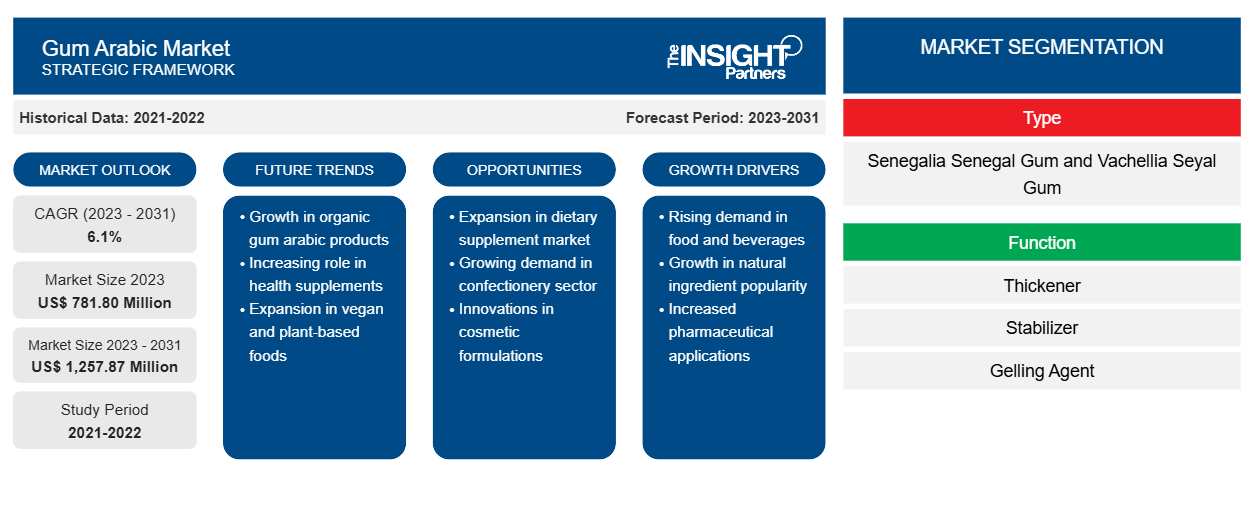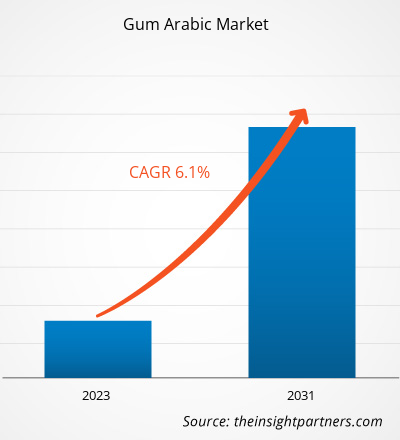The Gum Arabic Market size is projected to reach US$ 1,257.87 million by 2031 from US$ 781.80 million in 2023. The market is expected to register a CAGR of 6.1% in 2023–2031. Rising awareness regarding the health benefits of organic gum is likely to remain key Gum Arabic Market trends.
Gum Arabic Market Analysis
Gum arabic is used in food and beverages, pharmaceuticals, and personal care industries. Gum arabic serves as a thickening agent in the production of chewing gums, as a binder in watercolor paints, as an additive in ceramic glazes, and the rolling papers used in cigarettes. Also, gum arabic is the most popular natural emulsifier known globally, owing to its diverse applications. Gum arabic will register enormous growth in the upcoming year due to the global demand for natural products in the food and beverage industries. Consumers have switched to consuming natural food items because of the health benefits that are associated with natural foods. Gum arabic is used as an emulsifier, stabilizer, and thickening agent in icing, soft candy, fillings, chewing gum, and other confectionery and to bind the sweeteners and flavorings in soft drinks. Moreover, gum arabic is used in traditional lithography and printing. Gum arabic also provides the ink with excellent adhesion power that aids the permanence of the print. Hence, the diversity in the application of gum arabic is a strong factor driving the growth of the market globally.
Gum Arabic Market Overview
Gum arabic, also known as acacia gum, gum sudani, arabic gum, gum acacia, acacia, Indian gum, Senegal gum, and by other names, is a natural gum produced from the sap of the Acacia trees, available in the belt of arid lands in Africa, such as Sudan, Nigeria, and Chad. Gum arabic is extensively used in several application bases in the food & beverages industry. It acts as a binding agent to bind the food ingredients and significantly retain their physical characteristics. The rising application of gum arabic across the pharmaceutical and food & beverage industry provides lucrative opportunity for the major players operating in the Gum arabic market.
Customize This Report To Suit Your Requirement
You will get customization on any report - free of charge - including parts of this report, or country-level analysis, Excel Data pack, as well as avail great offers and discounts for start-ups & universities
Gum Arabic Market: Strategic Insights

-
Get Top Key Market Trends of this report.This FREE sample will include data analysis, ranging from market trends to estimates and forecasts.
Gum Arabic Market Drivers and Opportunities
Growing Awareness regarding Multi-Functionality of Gum Arabic
Gum arabic is considered to be natural, edible, and generally safe for human consumption. It has been used to treat various diseases improves the patients' digestive systems and appetite. Gum arabic is categorized as a nondigestible dietary fiber. It also exhibits some medicinal benefits, such as reducing dental plaque and healing of wounds, which encourage the application of gum arabic in the pharmaceutical sector, thereby propelling the growth of the global market for gum arabic. Also, gum arabic (acacia Senegal) is a complex polysaccharide indigestible to both humans and animals. Gum arabic is one the most commonly used foaming agents, used not only as a foaming agent but also as an emulsifier, drying agent, and stabilizer in various products. It is a natural plant-based hydrocolloid or plant or tree exudate composed of polysaccharide and Arabinogalactan protein (AGP) fractions. Therefore, growing inclination for natural products in the food and beverage industry, and related medicinal benefits are likely to enhance the market's growth in the forecast period.
Growing Demand for Gum Arabic Products
Gum Arabic product is obtained from the dried discharges of sticky stems and Acacia Senegal branches. Due to the rising demand for natural ingredients, various manufacturers focus on procuring food ingredients and raw materials that are naturally derived. The expanding scope of gum Arabic in dentistry is anticipated to provide potential opportunities to the market of gum Arabic. It is also a complex polysaccharide with a neutral pH of mixed magnesium, calcium, and potassium, promoting dental re-mineralization. Moreover, it also has some antimicrobial activity, which is further boosting its demand across the dentistry industry. Hence, the growing demand for gum Arabic from dentistry is anticipated to augment the market growth in the forecast period.
Gum Arabic Market Report Segmentation Analysis
Key segments that contributed to the derivation of the Gum Arabic Market analysis are type, function, and application.
- Based on type, the Gum Arabic Market is divided into senegalia senegal gum and vachellia seyal gum. The senegalia senegal gum segment held a larger market share in 2023.
- By function, the market is segmented into thickener, stabilizer, gelling agent, and others. The thickener segment held the largest share of the market in 2023.
- In terms of application, the market is segregated into bakery and confectionery, beverages, dairy and frozen products, and others. The bakery and confectionery segment leads the market in 2023.
Gum Arabic Market Share Analysis by Geography
The geographic scope of the Gum Arabic Market report is mainly divided into five regions: North America, Asia Pacific, Europe, Middle East & Africa, and South America/South & Central America.
European region comprises several developed and developing economies, such as Germany, France, Italy, UK, and Russia, among others. Transforming lifestyle trends concerning the food and beverage industry has had a noteworthy influence on the gum arabic market in Europe. With increasing health consciousness among consumers, the demand for gum arabic products in the region is expected to to grow over the projected period. The popularity of gum arabic has increased within the region, particularly in Germany, France, and the UK. Asia Pacific is anticipated to grow with the highest CAGR in the coming years.
Gum Arabic Market Regional Insights
The regional trends and factors influencing the Gum Arabic Market throughout the forecast period have been thoroughly explained by the analysts at The Insight Partners. This section also discusses Gum Arabic Market segments and geography across North America, Europe, Asia Pacific, Middle East and Africa, and South and Central America.
Gum Arabic Market Report Scope
| Report Attribute | Details |
|---|---|
| Market size in 2023 | US$ 781.80 Million |
| Market Size by 2031 | US$ 1,257.87 Million |
| Global CAGR (2023 - 2031) | 6.1% |
| Historical Data | 2021-2022 |
| Forecast period | 2023-2031 |
| Segments Covered |
By Type
|
| Regions and Countries Covered |
North America
|
| Market leaders and key company profiles |
|
Gum Arabic Market Players Density: Understanding Its Impact on Business Dynamics
The Gum Arabic Market is growing rapidly, driven by increasing end-user demand due to factors such as evolving consumer preferences, technological advancements, and greater awareness of the product's benefits. As demand rises, businesses are expanding their offerings, innovating to meet consumer needs, and capitalizing on emerging trends, which further fuels market growth.

- Get the Gum Arabic Market top key players overview
Gum Arabic Market News and Recent Developments
The Gum Arabic Market is evaluated by gathering qualitative and quantitative data post primary and secondary research, which includes important corporate publications, association data, and databases. The following is a list of developments in the market:
- ADM, a global leader in nutrition and agricultural origination and processing, and Asia Sustainable Foods Platform, a company focused on accelerating the commercialization of sustainable foods in Asia, today announced the official inauguration of their joint venture company, ScaleUp Bio. It is the first company in Singapore to provide contract development and manufacturing organization services for precision fermentation for food applications. (Source: ADM, Company News, 2022)
- Kerry, the world's leading taste and nutrition company, today officially opened the largest and most advanced taste manufacturing facility on the African continent. (Source: Kerry Group plc., Newsletter, 2022)
Gum Arabic Market Report Coverage and Deliverables
The “Gum Arabic Market Size and Forecast (2021–2031)” report provides a detailed analysis of the market covering below areas:
- Market size and forecast at global, regional, and country levels for all the key market segments covered under the scope
- Market dynamics such as drivers, restraints, and key opportunities
- Key future trends
- Detailed Porter’s Five Forces and SWOT analysis
- Global and regional market analysis covering key market trends, major players, regulations, and recent market developments
- Industry landscape and competition analysis covering market concentration, heat map analysis, prominent players, and recent developments
- Detailed company profiles
- Historical Analysis (2 Years), Base Year, Forecast (7 Years) with CAGR
- PEST and SWOT Analysis
- Market Size Value / Volume - Global, Regional, Country
- Industry and Competitive Landscape
- Excel Dataset
Recent Reports
Testimonials
Reason to Buy
- Informed Decision-Making
- Understanding Market Dynamics
- Competitive Analysis
- Identifying Emerging Markets
- Customer Insights
- Market Forecasts
- Risk Mitigation
- Boosting Operational Efficiency
- Strategic Planning
- Investment Justification
- Tracking Industry Innovations
- Aligning with Regulatory Trends





















 Get Free Sample For
Get Free Sample For